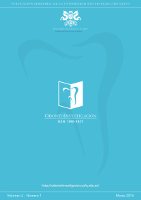Determinación del pH y Contenido Total de Azúcares de Varias Bebidas No Alcohólicas: su Relación con Erosión y Caries Dental
Main Article Content
Abstract
The aim of the study was to determine the values of pH and total content of sugar in different acidic and sweet drinks, as it relates to the appearance of dental erosion and tooth decay. 23 drinks were used: two (2) waters, five (5) soft drinks, two (2) natural fruit juices, four (4) industrial fruit juices, five (5) energy drinks, two (2) sports drinks, and three (3) industrial teas. These drinks were tested for pH and sugar content chemical-analytically. The pHs were between 2.30 and 3.40, except for distilled water (control group) and Dasani water without gas, 6.54 and 6.23 respectively. The most acidic beverage was Coca-Cola (2.30) and the least acid was the Sprite (3.40), both belonging to the group of soft drinks. The sugar content of most drinks was high, about 25 grams in a ½ liter container. The sweetest drinks were the lemonade and Monster, the energizer with 63 grams in ½ liter distilled water, Dasani water without gas, Coca-Cola Light and Sprite-Zero had 0 grams of sucrose/sugar. The beverage with the lowest pH and highest sugar content was the lemonade. Most beverages analyzed presented a pH level below the critical pH (5.5) to initiate the demineralization of tooth enamel and thus dental erosion, and high level of sugar associated with dental caries.
Article Details
References
Soares D., Scaramucci, T., Steagall, W.,Maia, S.R. & Pita, M.A. Interaction betweenstaining and degradation of a compositeresin in contact with colored foods. BrazOral Res. 2011 ;25 (4): 369-375.
Nirmala, S.V.S.G. A Comparative Study ofpH Modulation and Trace Elements ofVarious Fruit Juices On Enamel Erosion: Anin Vitro Study. Journal of Indian Society ofPedodontics and Preventive Dentistry.201 1 ;29 (3): 205-21 5.
Carvalho J.M., Maia, G.A., Sousa, P.M. &Rodríguez, S. Major Compounds Profiles inEnergeticDrinks:Caffeine,Taurine,Guarana, and Glucoronolactone. Rev InstAdolfo Lutz. 2006;65 (2): 78-85.
Inukai, J., Nakagaki, H., Itoh, M.,Tsunekawa, M. & Watanabe, K. RecentTrends in Sugar Content and pH inContemporary Soft Drinks. Journal ofDentistry for Children. 2011 ;78 (3): 138-142.
Kirk, R.S., Sawyer, R. &Egan, H.Composición y análisis de alimentos dePearson. México D.F.: Cecsa. 2004.
Romero, I. Medición de pH y Dureza.ProcedimientosComplementarios.Ensayos toxicológicos para la evaluación desustancias químicas en agua y suelo - LaexperienciaenMéxico. MéxicoD.F.:Secretaría de Medio Ambiente y RecursosNaturales (SEMARNAT). 2008.
World Health Organization. pH in Drinking water.Backgrounddocumentfordevelopment of WHOGuidelines forDrinking-water Quality. 2003.
Cavalcanti, A., Costa, M., Florentino, V.G.,dos Santos, J.A., Vieira, F.F. & Cavalcanti, C.L. ShortCommunication: Invitroassessment of Erosive Potential of EnergyDrinks. European Archives of PediatricDentistry. 201 0;1 1 (5): 253-255.
Kitchens, M. & Owens, B.M. Effect ofCarbonated Beverages, Coffee, Sports andHigh Energy Drinks and Bottled Water onthe in vitro Erosion Characteristics ofDental Enamel. Journal of Clinical PediatricDentistry. 2007;31 (3): 1 53-1 59.
Cavalcanti, A.L., A., Sarmento, P., Pierre, A.,Fernandez, F., Granville, A. & Leite, C. pHandTotal SolubleSolidContent inConcentratedandDilutedinNaturaTropical Fruit Juices. Acta EstomatológicaCroatica. 2008;42 (3): 229-234.
Ismail, A.I., Tanzer, J.M. & Dingle, J.L.Current Trends of Sugar Consumption inDevelopingSocieties.CommunityDentistryandOralEpidemiology.1 997;25:438-443.
Gualle,E.Caracterizacióndelosconsumidoresdebebidas,segúnvolúmenes de consumo, marca, opinionesy actitudes en general; en la ciudad deQuito. Escuela Politécnica Nacional. 2010.
Walton, A. How Much Sugar Are AmericansEating? Forbes. 2012.
Dantas de Almeida, L., Freire, G. M., Tejo,M., Dias, R. & Leite, A. Cariogenic anderosive potential of industrialized fruitjuices available in Brazil. Braz J Oral Sci.201 0;9 (3): 351 -357.
Garone, W. Lesiones No Cariosas: El NuevoDesafío de la Odontología. Sao Paulo:Santos Editora. 2009.

